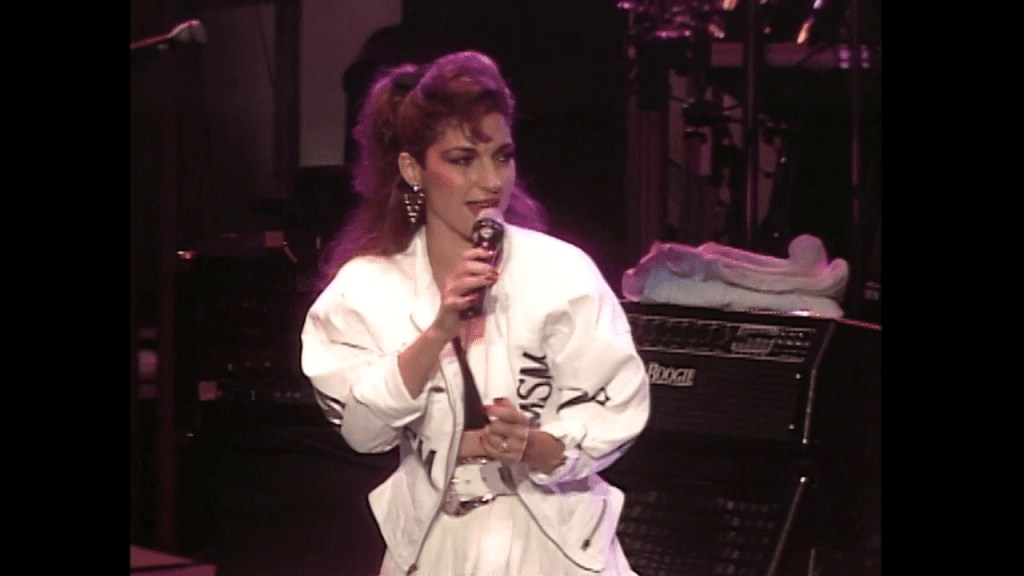
Gloria Estefan, often hailed as the “Queen of Latin Pop,” is an artist whose impact on music transcends borders and cultures. Among her many unforgettable contributions to the music world, Conga stands out as a defining moment in her career. Released in 1985 by Gloria and the Miami Sound Machine, Conga wasn’t just a song—it was a phenomenon. This infectious track blended Latin percussion with pop melodies, creating an irresistible rhythm that brought people to their feet and changed the course of music history.
Conga originated as an experimental fusion of sounds that Gloria and the Miami Sound Machine had been developing during their live performances. Written by Enrique “Kiki” Garcia, Emilio Estefan, and Gloria Estefan herself, the song was first introduced to audiences at a Miami club.
The audience’s reaction was overwhelming—people couldn’t stop dancing. Encouraged by the crowd’s enthusiasm, the band recorded Conga and included it on their album Primitive Love. What followed was nothing short of a cultural revolution, as the song broke through traditional barriers and brought Latin rhythms into mainstream pop music.
What made Conga so groundbreaking was its seamless blend of Latin and pop influences. The track prominently featured traditional Latin percussion instruments like congas, timbales, and bongos, combined with brass sections, synthesizers, and a driving pop beat.
Gloria’s vibrant and charismatic vocals brought the song to life. Her delivery was energetic and joyful, perfectly matching the rhythm and inviting listeners to join the party. The unforgettable chorus—“Come on, shake your body baby, do the conga”—became a universal call to the dance floor, ensuring the song’s enduring appeal.
At the time of Conga’s release, Latin music had not yet established a significant foothold in the mainstream American market. The song shattered these barriers, becoming the first to appear on Billboard’s pop, dance, black, and Latin charts simultaneously.

Conga wasn’t just a hit—it was a turning point. It proved that there was a global appetite for Latin music and opened doors for countless artists who followed in Gloria Estefan’s footsteps. Icons like Shakira, Ricky Martin, and Jennifer Lopez owe part of their success to the trail that Conga blazed in the music industry.
The success of Conga was unprecedented. It became a chart-topping hit across multiple countries, earning Gloria Estefan and the Miami Sound Machine international fame. The song was more than just music; it became a cultural symbol.
From weddings to corporate parties, Conga became a staple at celebrations. It united people across cultures, proving the universal power of rhythm and dance. Even decades later, the song remains a fixture at events and on dance floors around the globe.

A key factor in the success of Conga was Gloria Estefan’s dynamic live performances. Whether on television, at award shows, or during world tours, Gloria brought unmatched energy to every rendition of the song.
Her stage presence was electric, drawing audiences into the excitement and making them feel like part of the performance. The synchronized dance moves and infectious rhythm added to the spectacle, leaving an indelible impression on fans.
Even decades after its release, Conga continues to be a timeless classic. The song’s unique blend of cultural influences and its irresistible beat have ensured its place in music history. It has been featured in films, commercials, and countless playlists, remaining relevant across generations.
For Gloria Estefan, Conga was the launchpad for a career filled with groundbreaking achievements. The song’s success solidified her reputation as a global icon and a pioneer in Latin pop music.

While Conga was a defining moment, it was only the beginning for Gloria Estefan. She went on to release a series of chart-topping hits, including Rhythm Is Gonna Get You, 1-2-3, and Anything for You.
Beyond music, Gloria became a cultural ambassador, using her platform to promote Latin culture and advocate for various social causes. She also ventured into acting, writing, and business, further showcasing her multifaceted talent.

Conga is more than just a song—it is a celebration of culture, rhythm, and the unifying power of music. Gloria Estefan’s performance, combined with the innovative sounds of the Miami Sound Machine, created a masterpiece that continues to resonate with audiences around the world.
The song’s legacy is a testament to Gloria Estefan’s vision, talent, and determination to bridge cultural divides through music. Decades later, Conga remains a symbol of joy, unity, and the enduring power of great artistry.


